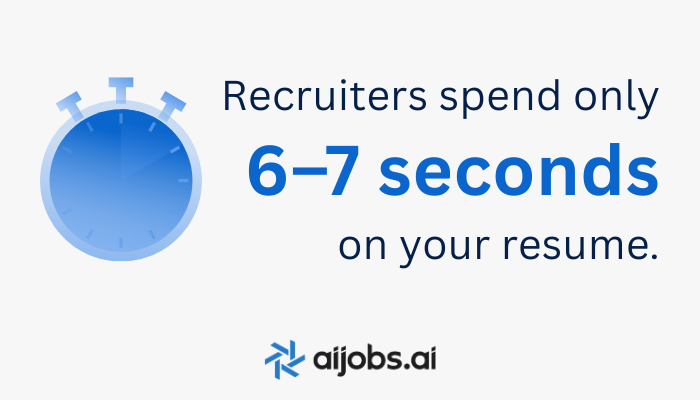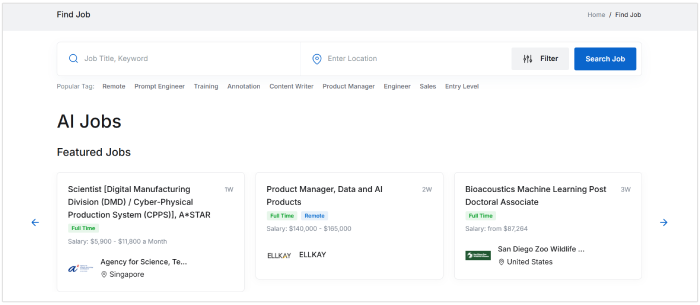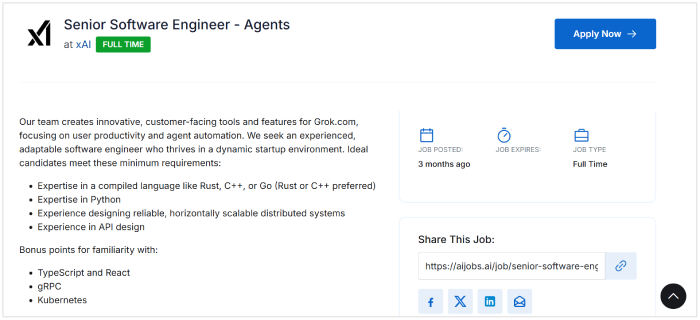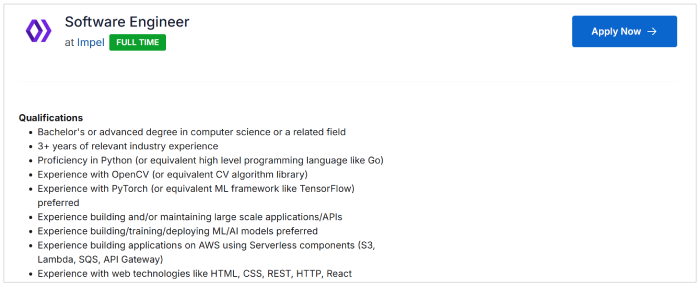How Many Skills Should You List on Your Resume?

How many skills should you list on your resume? And how do you pick the right ones to add?
This guide answers all your questions about resume skills.
You'll learn exactly how many skills to list, which ones employers value most, and how to present them in the best format for recruiters.
Whether you're just starting your career or you're a seasoned executive, these insights will help you create a skills section that helps you land your next dream job.
How Many Skills Should You List on Your Resume?
According to research from Zety, Americans list on average 9 skills in their resumes and this is based on data from 93,000 resumes.
However, the ideal number of skills on your resume depends on your experience level and the specific job you're applying for.
For instance, the same study also found that directors list 19 skills on average on their resumes.
Whereas, a more junior position like a developer reported adding an average of 9 skills.
But remember, when it comes to how many skills you should put on your resume, quality always beats quantity.
It's better to list 7 highly relevant skills than 15 generic ones. Each skill you add should directly support your fit for the position that you're applying for.
Research from several sources shows that recruiters typically spend just 6–7 seconds scanning a resume before deciding whether to keep reading. Your skills section is often the first place they look to determine if you're qualified for the position or not.

Why Your Resume Skills Section is Important
Your skills section serves multiple important purposes:
- ATS Compatibility: Applicant Tracking Systems scan for specific keywords from job descriptions. Including the right skills helps your resume pass these initial screenings.
- Quick Assessment: Hiring managers use your skills section to rapidly evaluate your qualifications. It's often their first stop when reviewing applications.
- Competitive Advantage: A well-written skills section immediately shows you have what employers need, setting you apart from other candidates.
- Value Demonstration: Your skills section clearly communicates the value you'll bring to the organization from day one.
Your resume's skills section is prime real estate for highlighting your personal skills.
- Sam Wright, Head of Operations and Partnerships at Huntr
Research shows that resumes with targeted skills sections are 58% more likely to get callbacks than those without them.
Looking for a job in AI or ML? Check out all the open positions from leading technology companies on AI Jobs.

Where to Place Your Skills Section in Your Resume
The placement of your skills section depends on your resume format:
- Reverse-Chronological Resume: Place skills after your work experience section. This format works best for most professionals since it emphasizes career progression.
- Functional Resume: Put skills first, before work experience. This approach works if you're changing careers or have employment gaps.
- Combination Resume: Feature key skills near the top, then follow with work experience. This format works well for mid-career professionals with diverse expertise.
For most job seekers, the reverse-chronological format with skills listed after work experience performs best with both ATS systems and human readers.
Hard Skills vs. Soft Skills
Understanding the difference between hard and soft skills is essential for creating an effective resume.
Hard Skills
Hard skills are specific, measurable abilities you can prove and demonstrate.
Examples of hard skills in programming and tech include:
- Programming languages (Python, JavaScript, SQL)
- Software platforms (Salesforce, HubSpot, Adobe Creative Suite)
- Technical processes (Data analysis, financial modeling)
- Certifications (AWS Certified Developer, TensorFlow Developer Certificate)
Key takeaway: Your skills section should focus primarily on hard skills. These are what ATS systems scan for and what hiring managers use to assess technical qualifications.
Soft Skills
Soft skills relate to your personality and work style.
Examples of soft skills include:
- Communication
- Leadership
- Problem-solving
- Time management
- Adaptability
Important: Don't list soft skills in your dedicated skills section. Instead, demonstrate them through specific examples in your work experience and professional summary sections.
For instance, instead of listing "leadership," write: “Led cross-functional team of 12 through product launch, adapting strategies based on market feedback and delivering project 2 weeks ahead of schedule.”
How to Select the Right Skills for Your Resume
Follow these steps to choose the most effective skills for your specific situation:
Step 1: Analyze the Job Description
Read job postings carefully and identify common patterns.
What skills, tools, or qualifications appear multiple times across several job descriptions?
These are your priority keywords.
For instance, this job description for a Senior Software Engineer at xAI has the following required skills:
- Expertise in compiled language like Rust, C++, or Go
- Expertise in Python
- Experience designing, horizontally scalable distributed systems
- Experience in API design

Likewise, this job listing for a Software Engineer at Impel lists these skills as requirements:
- Proficiency in Python (or equivalent high level programming language like Go)
- Experience building and/or maintaining large scale applications/APIs
- Experience with web technologies like HTML, CSS, REST, HTTP, React

As you can see, both these job listings share similar required skills.
Look for:
- Required technical skills
- Preferred software or platforms
- Industry-specific knowledge
- Certifications mentioned
Step 2: Match Your Experience
Compare the job requirements with your actual abilities.
Important: Only include skills you can confidently discuss in an interview and demonstrate if needed.
Ask yourself:
- Have I used this skill in a professional setting?
- Can I provide specific examples of results I achieved?
- Am I comfortable being tested on this skill?
I would always look for how the experience detailed matches up to the job description or job advert. This is what employers will be looking for.
- Lee Owen, Director of South East Finance at Hays
Step 3: Prioritize by Relevance
Arrange skills with the most job-relevant ones first.
If a position emphasizes data analysis and project management, those should appear at the top of your list, not buried among general tools like Microsoft Office.
Step 4: Research Industry Standards
Look beyond single job postings.
Review multiple listings in your field and check LinkedIn profiles of people in similar roles.
This helps ensure you're not missing important skills or including ones that are considered basic at your level.
Common Mistakes to Avoid when Listing Skills on Your Resume
Avoid these errors that can weaken your skills section:
- Including Outdated Technology: Don't list obsolete software or tools you haven't used recently. This makes your experience seem dated.
- Using Skill Rating Systems: Avoid star ratings or percentage bars. These ratings are subjective and most employers ignore them.
- Adding Skills You're Still Learning: Don't list abilities you can't confidently demonstrate. If you're currently learning something, note it as "In progress" or leave it off entirely.
- Listing Everything You Know: Focus on relevance over quantity. Including every skill dilutes the impact of truly important ones.
- Using Vague Buzzwords: Terms like "go-getter" or "team player" don't belong in your skills section. Show these qualities through your work experience instead.
- Including Skills You Want to Avoid: Only list skills related to work you actually want to do. Otherwise, you might get hired for responsibilities you're trying to move away from.
- Inconsistent Naming: Use consistent terminology throughout (e.g., stick with either "Google Workspace" or "G Suite," not both).
Should You List All Your Skills on Your Resume?
No, you should not list all your skills on your resume.
Here's why selective inclusion works better:
- Relevance Matters Most: Employers care about skills that directly relate to the open position. Including unrelated abilities just takes up valuable space.
- ATS Optimization: Applicant Tracking Systems look for specific keywords from job descriptions. Irrelevant skills won't help your resume get past these initial screens.
- Hiring Manager Focus: As we've established, recruiters spend seconds scanning resumes. A focused skills section helps them quickly identify your key qualifications.
- Interview Preparation: Only include skills you're prepared to discuss in detail during interviews. Every listed skill is potential interview material.
- Strategic Positioning: Your resume should position you for the role you want, not just showcase everything you can do.
Formatting Your Skills Section the Right Way
How you present your skills is just as important as the skills you list in your resume.
One factor that makes many resumes difficult to read is large paragraphs without much formatting, bullets, bolding, or other ways to distinguish the key information.
- Biron Clark, Founder at Career Sidekick
Follow these formatting guidelines:
Use Clear Organization: Group similar skills together (e.g., "Programming Languages," "Project Management Tools," "Marketing Platforms").
Choose Clean Layout: Present skills in easy-to-scan columns or short lists. Avoid long paragraphs or cluttered formatting.
Prioritize: List the most job-relevant skills first within each category.
Keep It Consistent: Use parallel structure and consistent terminology throughout the section.
Make It Readable: Use standard fonts and formatting that both humans and ATS systems can easily process.
Example Format:
Technical Skills: Python, SQL, Tableau, Google Analytics, Salesforce
Project Management: Agile/Scrum, Asana, Jira, Budget Management
Tailoring Skills for Different Career Levels
Your approach to listing skills should evolve with your career:
Entry-Level Professionals
- Include technical skills learned in school or internships
- Emphasize transferable skills from part-time work or projects
- Highlight any certifications or training programs completed
Mid-Career Professionals
- Balance technical abilities with industry knowledge
- Include management or leadership-related capabilities
- Focus on skills that show progression and growth
Senior-Level Professionals
- Emphasize strategic and leadership capabilities
- Include industry-specific expertise developed over time
- Focus on skills that demonstrate your ability to drive results
Frequently Asked Questions
How many technical skills should I put on my resume?
Include 5-10 technical skills that directly relate to your target role. Focus on the most current and relevant technologies rather than trying to list everything you've ever used.
Should I include Microsoft Office skills on my resume?
For most professional roles, basic Microsoft Office skills are assumed. Only include them if the job specifically requires advanced features or you have expert-level capabilities in specific programs.
Can I list skills I'm currently learning?
Only if you note them as "In progress" or "Currently studying." Be prepared to discuss your learning timeline and current proficiency level in interviews.
How do I choose between similar skills?
Use the exact terminology from the job description when possible. If a posting mentions "Salesforce" specifically, use that instead of “CRM software.”
Should entry-level candidates list soft skills?
No, avoid listing soft skills in your dedicated skills section. Instead, demonstrate them through specific examples in your work experience, volunteer work, or project sections.
How often should I update my skills section?
Review and update your skills section for each job application. Also conduct a comprehensive review every 6 months to add new abilities and remove outdated ones.
Conclusion
Your resume's skills section is more than just a list.
You should think of it as a tool that can position you as the ideal candidate.
By carefully selecting relevant skills, formatting them effectively, and tailoring them to each opportunity, you create a powerful first impression that opens doors.
Remember that your skills section works best when it complements the rest of your resume. Use specific examples in your work experience to back up the capabilities you list, and ensure everything aligns with your target role's requirements.
Start by analyzing your dream job's requirements, inventory your relevant abilities, and craft a skills section that clearly demonstrates why you're the perfect fit.
With the right approach, your skills section becomes a competitive advantage that helps you stand out in any applicant pool.











